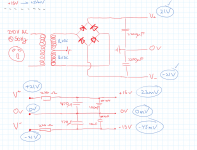My bad, i forgot how capacitors worked for a minute. Back on track now
I've removed the capacitors which lead to the -+15V plug which has resulted in
-+21V at the plug.
I briefly connected the amp together again and powered it on (without the capacitors) - the LED's lit up nicely.
I am now in the process of testing these capacitors to figure out which ones short the circuit.
I've removed the capacitors which lead to the -+15V plug which has resulted in
-+21V at the plug.
I briefly connected the amp together again and powered it on (without the capacitors) - the LED's lit up nicely.
I am now in the process of testing these capacitors to figure out which ones short the circuit.
yikes don't run it like that for long...without a current limiter, a la "Dim bulb tester"!
is your multimeter digital/lcd or analog?
i miss analogs ability to show trends...
is your multimeter digital/lcd or analog?
i miss analogs ability to show trends...
Last edited:
I bet you removed not only the capacitors but the Zeners too, you will burn preamp Op Amps.I've removed the capacitors which lead to the -+15V plug which has resulted in
-+21V 😱 at the plug.
Keep checking power supply with Preamp disconnected until you get +/- 15V; only then plug preamp back.
Does the preamp SOUND properly?I briefly connected the amp together again and powered it on (without the capacitors) - the LED's lit up nicely.
A shining LED by itself is not enough sign of preamp health.
IF any of them is the cause, they are very low in my suspect list.I am now in the process of testing these capacitors to figure out which ones short the circuit.
Just in case junk them, and put a fresh couple there, also replace Zeners, although I wouldn´t be surprised by a solder short or similar
Hopefully a diagram will show where i am at more easily:
i drew up everything i could see between the transformer and the -+15V supply
Currently i have it hooked up as shown but without the #104 capicitors (100nF).
I think the zener diodes are on the pre-amp board
I did end up testing the amp like this and it plays well. Maybe the improvement is a product of re-soldering and tidying up much of the supply circuit.
i drew up everything i could see between the transformer and the -+15V supply
Currently i have it hooked up as shown but without the #104 capicitors (100nF).
I think the zener diodes are on the pre-amp board
I did end up testing the amp like this and it plays well. Maybe the improvement is a product of re-soldering and tidying up much of the supply circuit.
Attachments
so what do the 470's measure out of circuit?
your 220 ohm resistors measure within tolerance?
how is possible to have it play fine when, by your stated measurements, there's insufficient voltage to turn the op-amps on!!!
your 220 ohm resistors measure within tolerance?
how is possible to have it play fine when, by your stated measurements, there's insufficient voltage to turn the op-amps on!!!
I think NOW we have +/-15V present, not before.
Suspect a solder bridge which was corrected when pulling capacitors.
Or cracked open tracks now resoldered.
I expect 15V Zeners *somewhere*, either on preamp board or on main supply one, just not nevessarily *near* filter caps or connector.
I´d follow any tracks connected to connector pins.
21 to 15V drop through 220r hints at about 27mA consumption, highish for a preamp but not impossible by any means, specially if it´s a complex one.
And Zeners would take any excess current not pulled by Op Amps and such.
Suspect a solder bridge which was corrected when pulling capacitors.
Or cracked open tracks now resoldered.
I expect 15V Zeners *somewhere*, either on preamp board or on main supply one, just not nevessarily *near* filter caps or connector.
I´d follow any tracks connected to connector pins.
21 to 15V drop through 220r hints at about 27mA consumption, highish for a preamp but not impossible by any means, specially if it´s a complex one.
And Zeners would take any excess current not pulled by Op Amps and such.
Last edited:
- Home
- Live Sound
- Instruments and Amps
- Ibanez TBX15R - Broken
